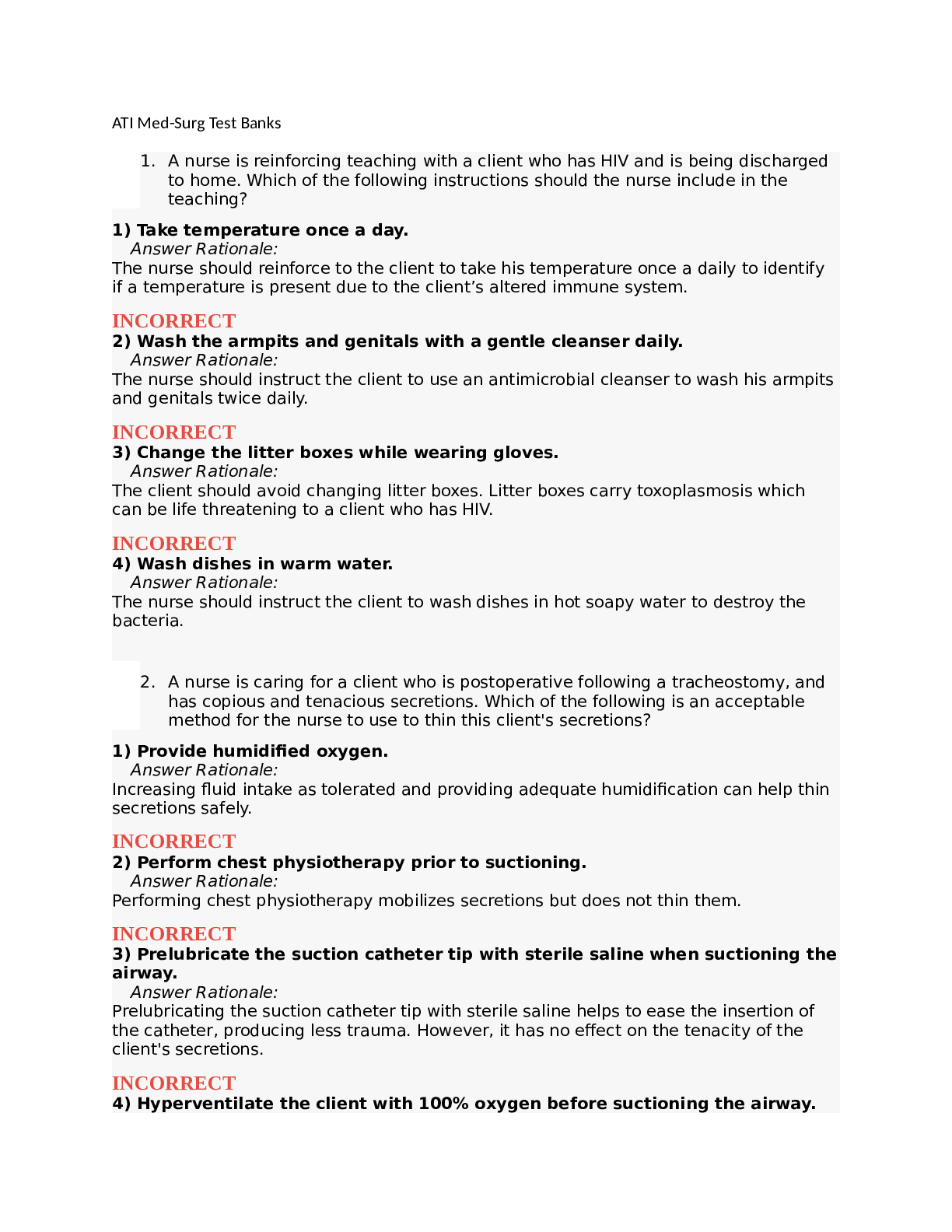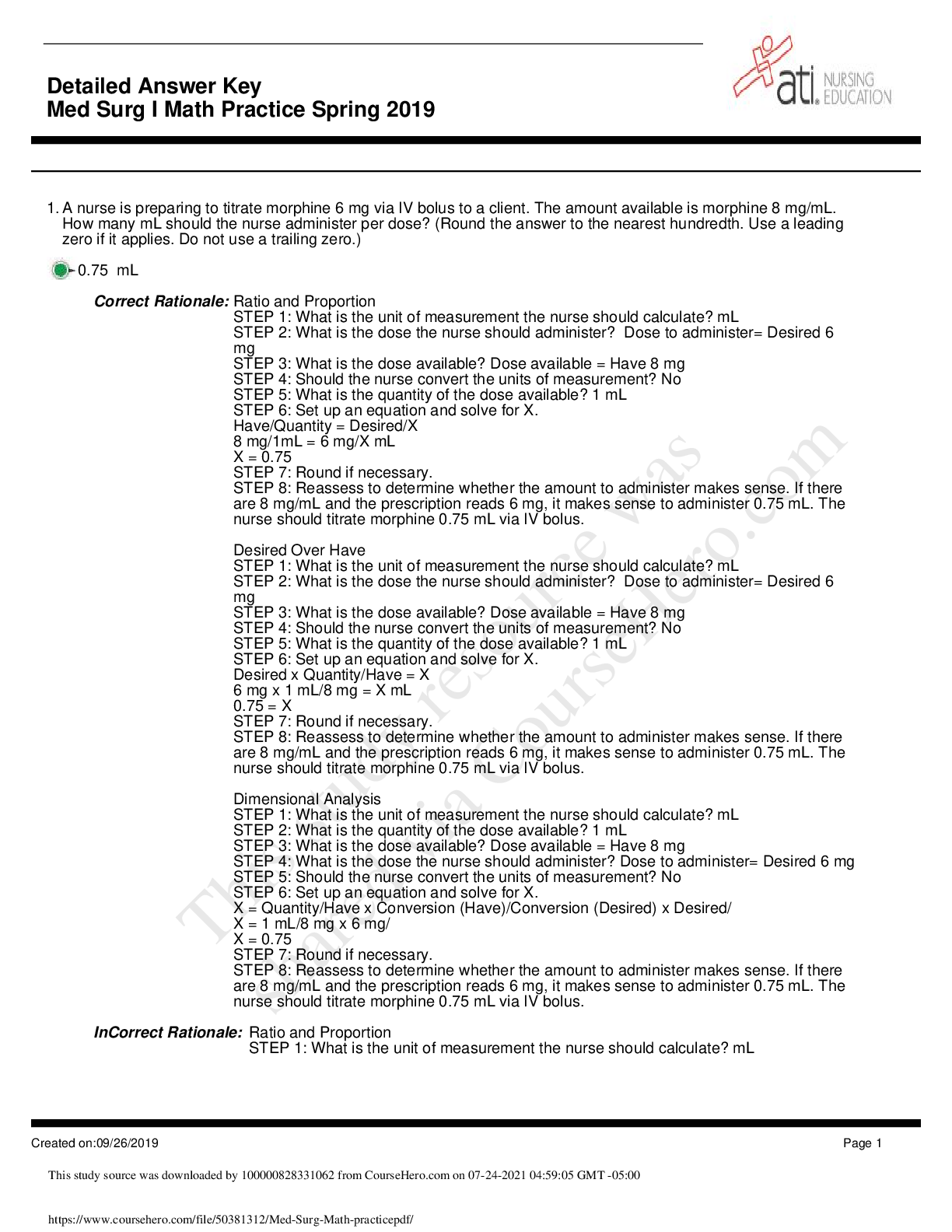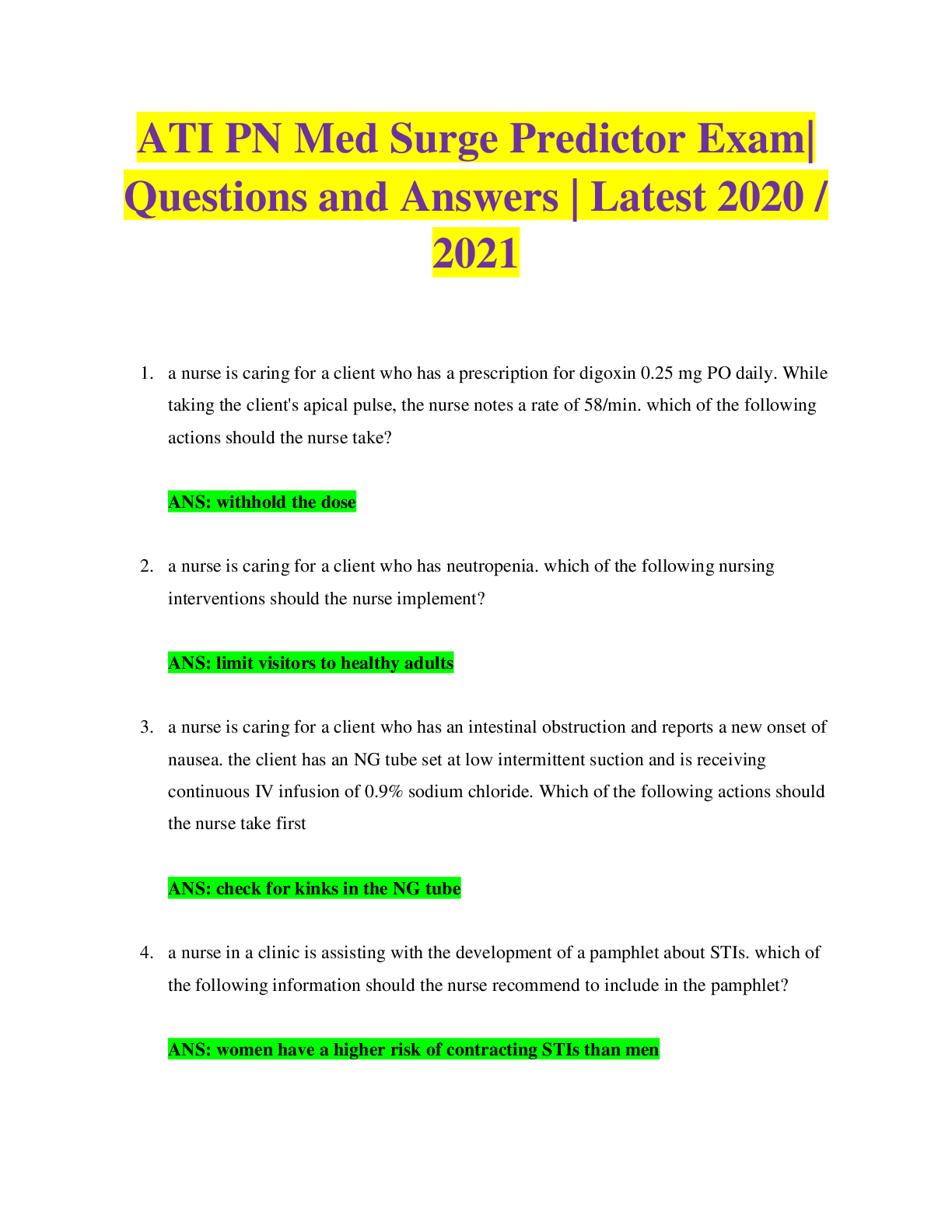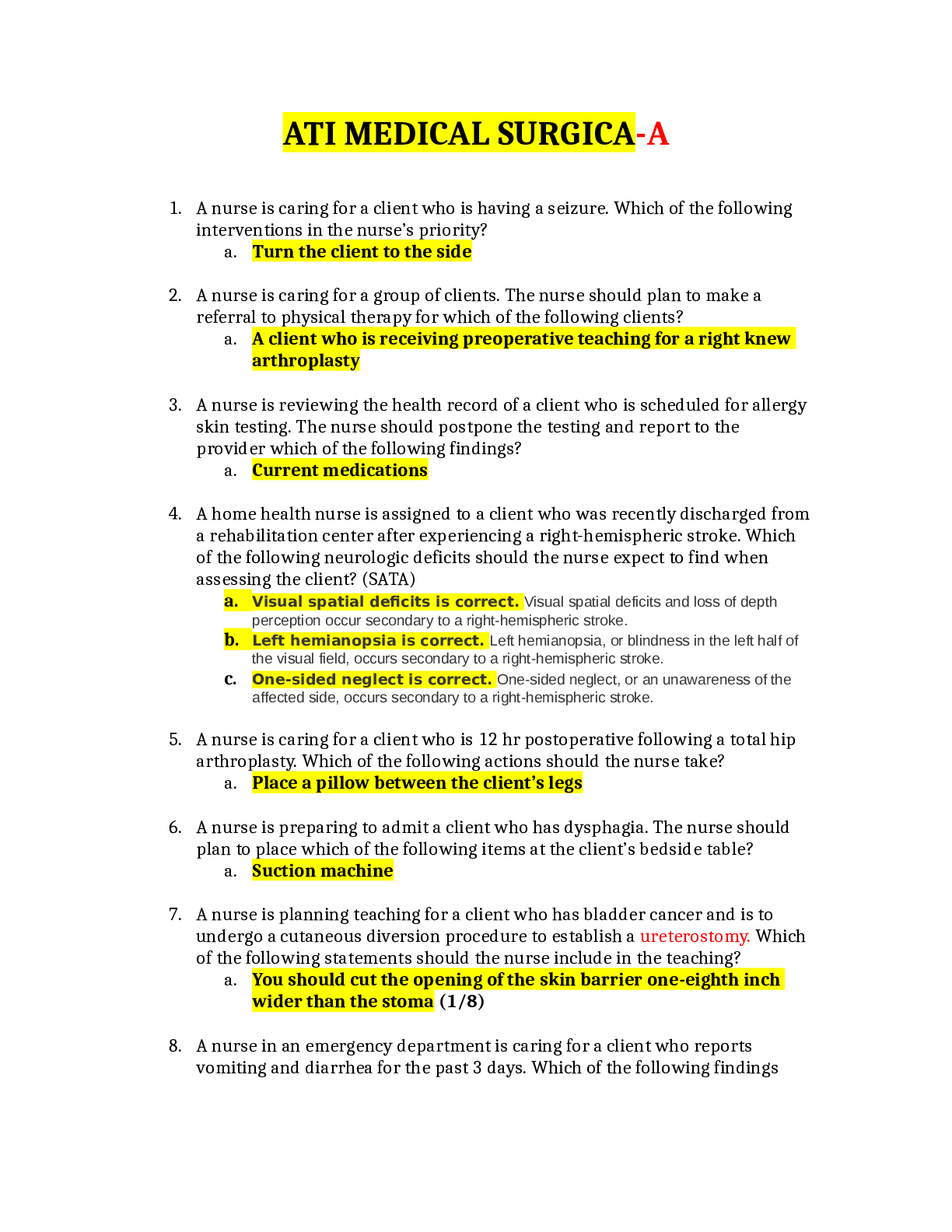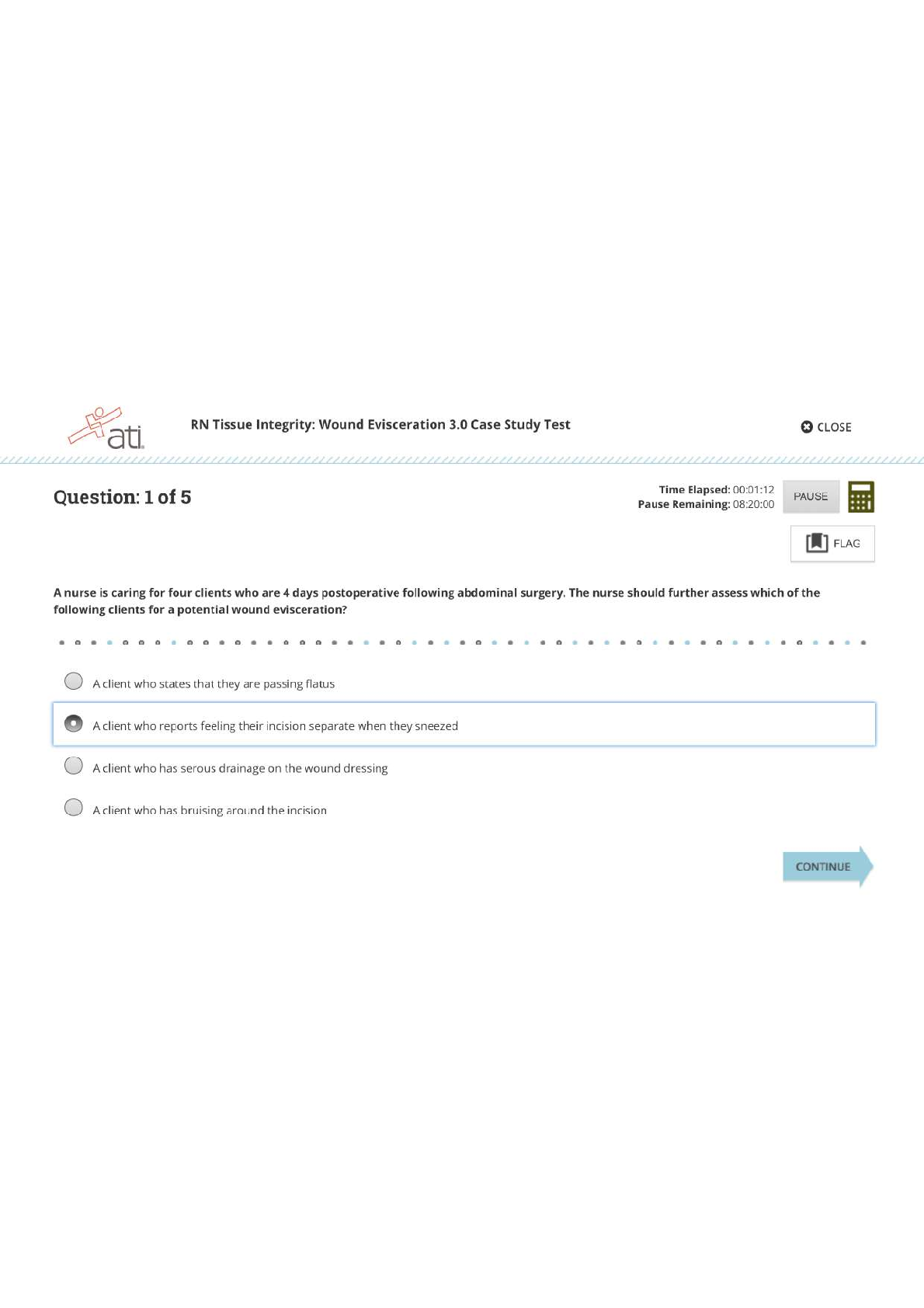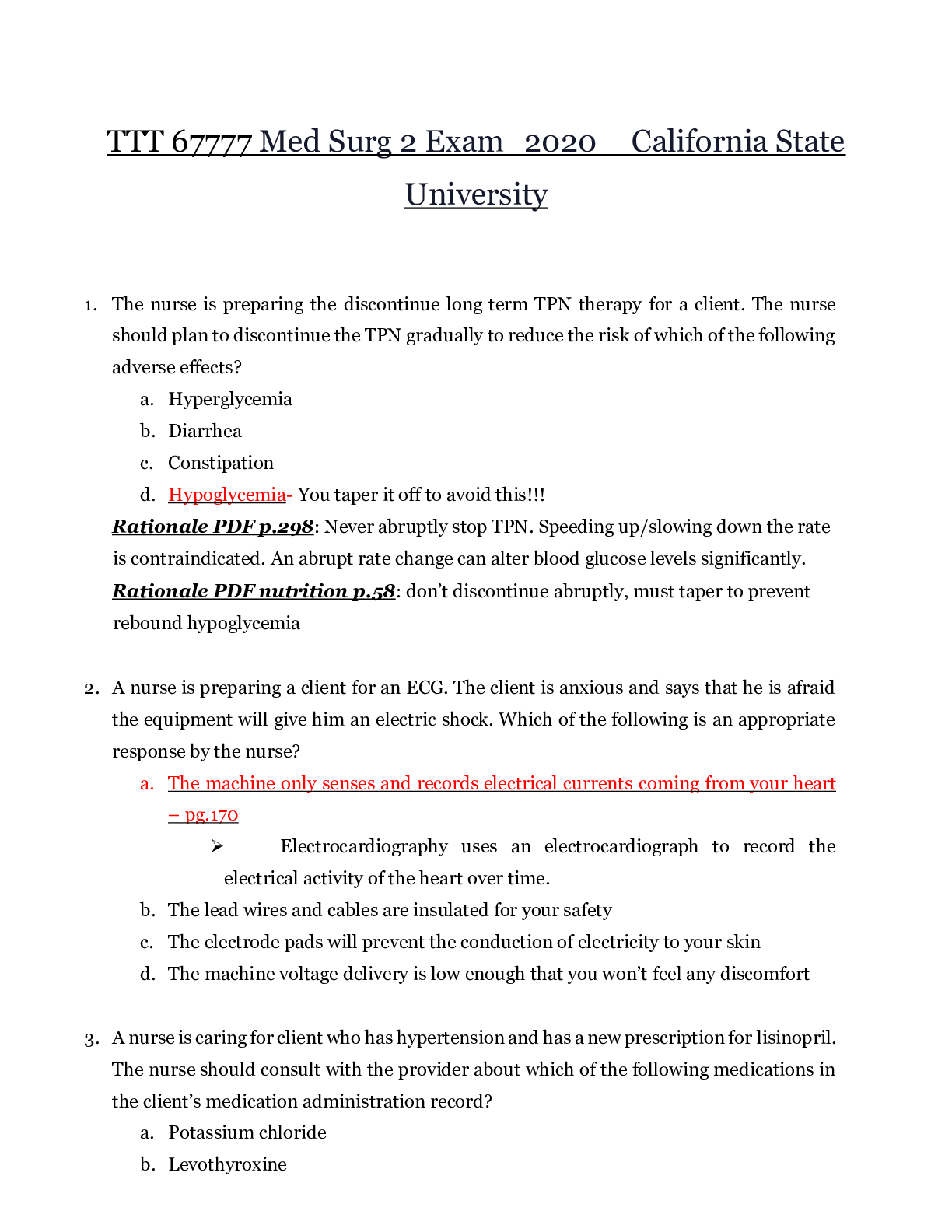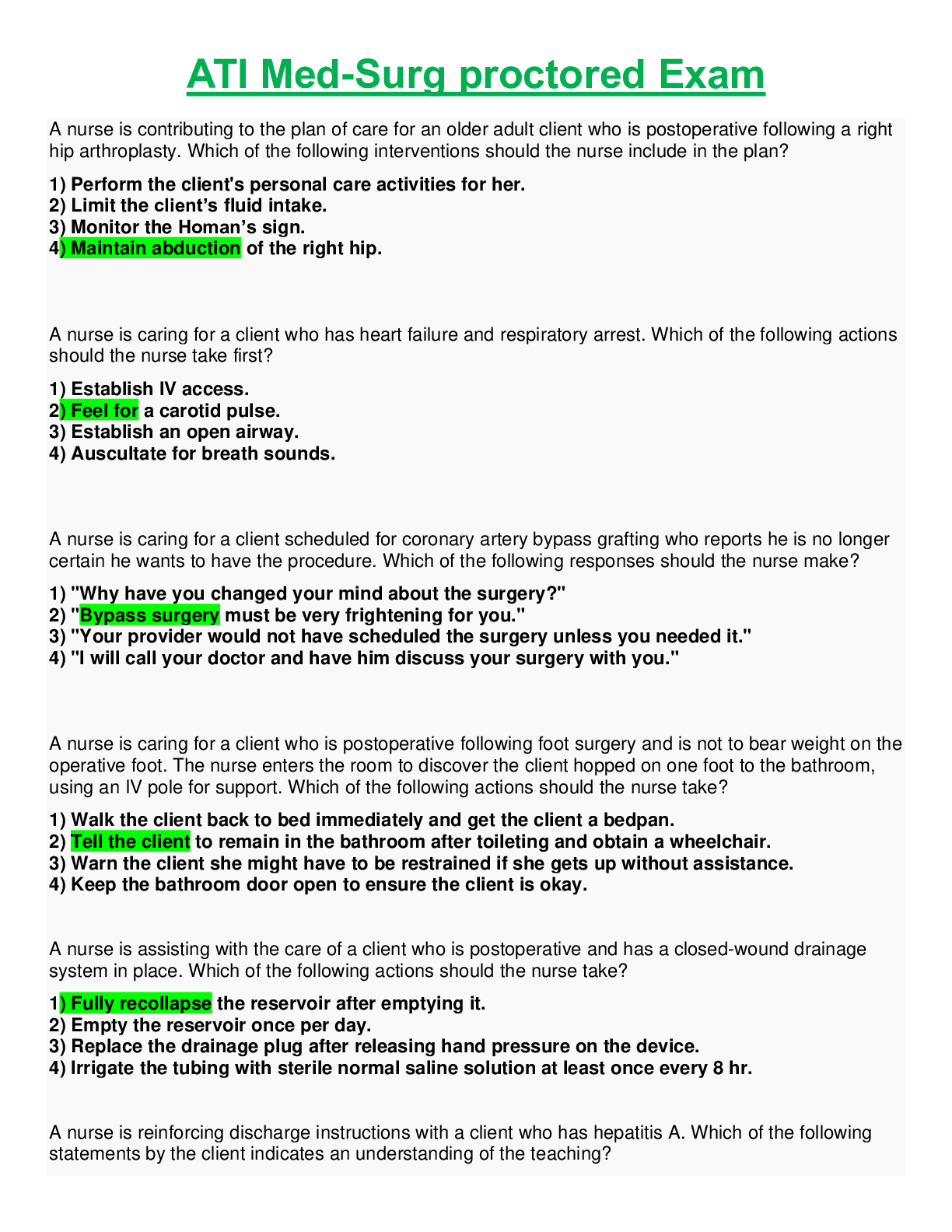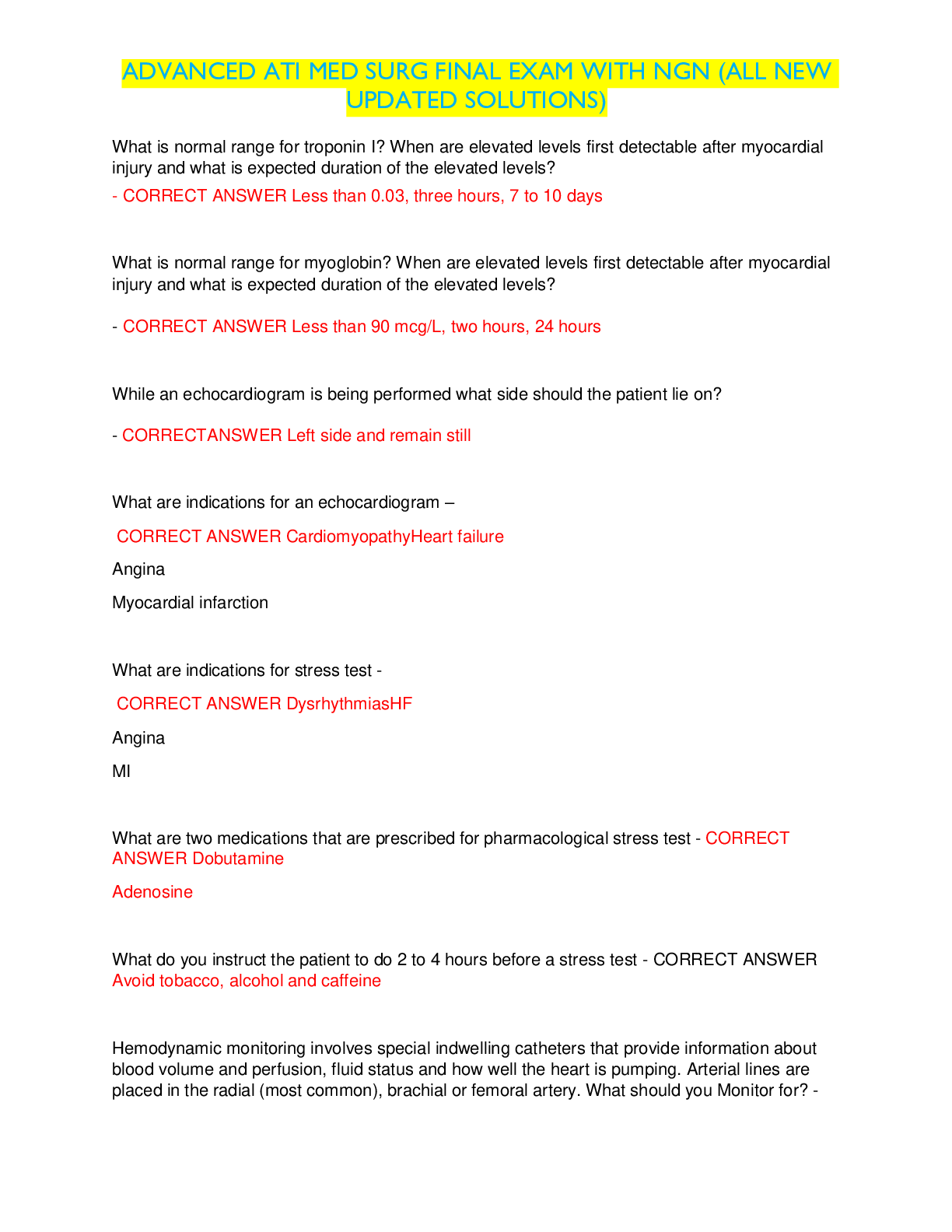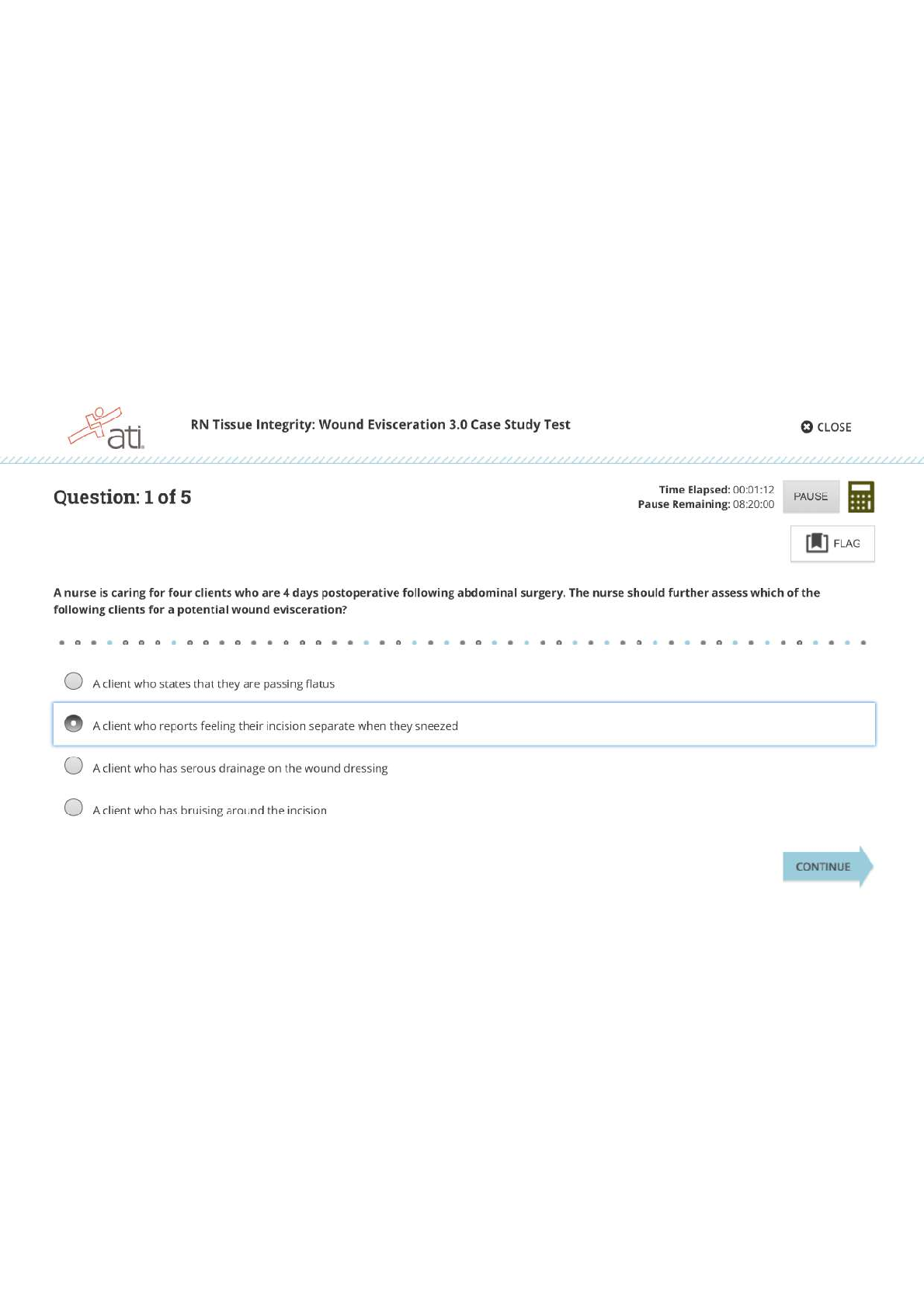*NURSING > ATI MEDICAL SURGICAL > NUR 1234 ATI MEDSURG (All)
NUR 1234 ATI MEDSURG
Document Content and Description Below
NUR 1234 ATI MEDSURG 11. How do you insert a PICC? PICC- Flat on back (Review Pg. 303) Subclavian IV catheter- Trendelenburg position (head below feet) 12. You are removing a peripheral i... nserted central catheter, which of the following would you do following removal? Answer: Measure the length of the external portion of the catheter 13. Removing a peripheral IV catheter- Answer: make sure the tip is intact 14. Patient has INR of 1.5 prior to surgery. What are you going to do? Answer: Prep the patient for surgery 15. Following the surgical placement of a new ileostomy, which of the following would you teach them? Answer: chew food well Rationale: Patients with a new ostomy involving the small intestine (i.e. an ileostomy) are told post-op to avoid foods that increase flatus (green leafy vegetables, beer, carbonated beverages, dairy, and corn); avoid high-fiber foods for first 2 months; CHEW FOOD WELL; increase fluid intake; and evaluate evidence of blockage. 16. A patient is on isolation due to C difficile infection; which of the following represents correct infection protection protocol? Answer: Collect fecal sample with gloves 17. A patient ____(has either a list of symptoms or a new prescription for anti-coagulant)________ during medical history they report they have been TAKING IBUPROFEN FOR 3 YEARS. What lab would you expect to be drawn? Answer: Fecal Testing/Stool Guaiac/ Fecal Occult Blood Test (FOBT) 18. A patient has been on total parenteral nutrition for 10 full days, which of the following would be an indication that the nutrition therapy is effective? Answer: Potassium 4.0 (Pg.524) 19. Which of the following clients is MOST at risk for developing atelectasis? Answer: Post anesthesia for bowel resection o Rationale: This patient was the only patient who had abdominal surgery; patients with abdominal surgery are at the HIGHEST risk for atelectasis because the pain from incision/surgical procedure causes them to reflexively breathe in a shallow, cautious way. Positioning (guarding) also causes decreased in lung expansion. 20. The nurse is preparing a patient for paracentesis procedure, which of the following instructions would be given to the patient to decrease the risk of perforation? Answer: Instruct patient to empty their bladder prior to the procedure, this is done in order to decrease the size of a bladder and it reduces the chance of accidental bladder perforation.Pg 527 21. The nurse is providing home care for a patient receiving peritoneal dialysis, the patient has a fever of 102, and the catheter has decreased dialysate outflow. Which of the following should the nurse perform first? Answer: Reposition the patient o Rationale: Nursing Actions regarding reduced or inadequate outflow include: repositioning the client (b/c this moves the distal lumen of the catheter which may become pressed up against the abdominal wall = obstruction); milk the tubing if a visible clot is present in the catheter; check the tubing for kinks or closed clamps, determine when the patient’s last bowel movement was (constipation can also cause low outflow, pts on peritoneal dialysis are instructed to use a stool softener daily and consume a high-fiber diet). 22. The nurse is caring for a patient with Crohn’s Disease. Which of the following would be an expected lab value for this patient? Pg 582 • HCT and HGB – LOW in crohn’s due to anemia • ESR, CRP – HIGH (rationale: ESR & CRP are reflections of non-specific/general inflammation, think INFLAMMATORY bowel condition • WBC Count = Increased because of inflammatory response • Anti-glycan Antibodies= Antiglycan is a certain type of protein present on the cells of individuals with Crohn’s Disease. These are found in the vast majority of patient’s with Crohn’s. • Electrolytes (K+, Mg, Ca, etc), Protein/Albumin, Iron and Other Measures of Nutrition = LOW (rationale: pts with crohn’s experience 5 or more loose stools a day and are almost always malnourished due to self-limitation of foods b/c of pain and GI upset caused by ingestion AND because inflammation of the GI tract causes malabsorption). 23. The nurse is caring for a patient a patient with cancer who is hospitalized following chemotherapy and has an extremely low WBC count of 500? The family asks to bring the patient the following items, which should the nurse allow the patient to have? ANSWER: boxed chocolates o Rationale: commercially prepared goods have been prepared under sterilized conditions and candy is heated to a very high temp in order to convert it to candy. 24. Gun shot wound to abdomen. What would you do to prevent acute kidney failure? Answer: FLUIDS 25. The nurse is assessing a patient with open-angle glaucoma, which of the following would be an expected assessment finding? Answer: Loss of Peripheral Vision o Rationale: Blurred Vision, Halos, Nausea, and Severe Pain are s/s of acute ANGLE CLOSURE GLAUCOMA, not open-angle. Open Angle Glaucoma = a disruption of structure and function of the optic nerve that causes decreased drainage of aqueous humor due to blockage. Impaired drainage of fluid increases the intra-ocular pressure (IOP) and impairs straight-line and peripheral vision. 26. A nurse is caring for a patient who is s/p knee arthroplasty, the patient reports pain and swelling at the the incision site. Which of the following non-pharmacological nursing interventions should the nurse perform to help relieve the patient’s pain? Answer: Apply Cold Pack/Ice 27. A nurse is caring for a patient immediately following hip arthroplasty. Which of the following interventions should be performed in order to immobilize the joint? (Pg 761) Answer: Use an abduction pillow or pillow between legs • INCORRECT: Perform passive ROM exercises • INCORRECT: Place pillow behind the knee for support 28. A nurse is caring for a patient post-op after an appendectomy, while assessing the patient she notices bleeding on the bandages. How should the nurse measure and record the volume of blood? Answer: Draw circle around it. 29. The nurse is caring for an older adult patient immediately following a total hip arthroplasty procedure. To prevent dislocation of the hip, the nurse should do which of the following? Answer: Place a pillow between legs when turning to the unoperative side. 30. Who would you assess first? Answer: Tracheal deviation to the right. 31. A nurse is caring for a patient who requires intubation for respiratory support. An Endotracheal tube is inserted, but the patient’s respiratory status is still compromised and the nurse suspects the tube may be in the right bronchus. How would the nurse confirm her suspicion? Answer: The patient would have absent lung sounds on left 32. The nurse is caring for a patient receiving radiation therapy for a malignancy. What instructions would the nurse give the patient regarding the care of the site following the radiation treatment? Pg1004 Answer: Gently pat the area dry, do not rub. o Rationale: Patient’s receiving external radiation therapy (ERT) are instructed to wash the area with mild soap or water, gently pat the area dry. They are told to be careful not to wash off the radiation “tattoos” which are skin markings that mark where to apply the radiation. Patients are also advised to wear soft, loose, non-restrictive clothing which implies an occlusive dressing is contraindicated as well. They are instructed not to apply any lotions, perfumes, powders, or deodorants to the site. 33. When performing a wound culture of a wound with eschar and exudate; using a sterile cotton swab, the culture should be obtained by: Answer: Using a circular motion in the pool of exudate 34. The nurse is performing wound care for a patient whose wound requires debridement using wet-to-dry packing. What type of debridement is this considered. Answer: mechanical 35. Instructions for a post op thyroidectomy patient. ATI Pg. 872-77 36. Positive Trousseau sign. What electrolyte imbalance is occurring? Answer: hypocalcemia 37. Click on the exhibit to view the patient record and answer the question. According to the exhibit, which medication would you hold? Answer: captopril (ACE, monitor HR) 38. Teaching regarding TB meds. Answer: you will be on meds for 6-12 months 39. The nurse is caring for a patient newly prescribed metformin. What instructions should the nurse include? Med should be taken WITH food to minimize GI SE, Patients should take B12 & folic acid, never crush or chew Pg 917 40. The nurse is caring for a patient who is experiencing thyroid storm. Which of the following would you expect to be done: Answer : Cooling blanket Pg. 875 41. Myxedema Review page (page 887) 42. Urography findings? Review (page 633) 43. Diabetes/ PVD foot care? Answer: cut toe nails straight across Pg 920 44. Which of the following would require airborne precautions? Answer: measles 45. Lupus question Review (page 964) 46. Raynaud’s phenomenon Review (page 965) - pallor in extremities 47. Would evisceration Answer: Cover with warm sterile saline dressing (Pg1111) 48. Administering Digioxin, what’s a finding to report to provider immediately? N/V, visual disturbances 49. 3rd degree heart block, what do you do? Answer: Initiate Temporary Pacing with an External Pacemaker Immediately 50. Afib – what drug would you give? Meds: Antiarrhythmic medications- Amiodarone, adenosine, verapamil (Pg. 314) 51. Lisinopril ACE inhibitor that treats high blood pressure and heart failure. Prevents vasoconstriction. Monitor BP and pulse. Hypotension is a common AE. Patient should report cough (Pg 412) 52. The nurse is caring for a patient who has a new prescription for metoprolol “Lopressor” (Beta Blocker) What would the nurse monitor for. Pg. 413- Monitor BP and Pulse, can mask hypoglycemia in patients with diabetes. 53. How do you irrigate an ear? Answer: Tilt head at 45 degrees up 54. Care of a stroke patient? (Review pg. 155) Monitor Vitals q1-2 hours, elevate clients HOB 30 degrees to reduce ICP, TPA should be given within 4.5 hours of the initial symptoms, monitor for changes of LOC, ECG monitoring, have suction on standby, seizure precaution, encourage passive ROM q2h 55. Which mask delivers 70% O2? • Nasal cannula (24-44 percent) • Answer: Partial rebreather (60-75 percent) • Non rebreather (80-95 percent) • Venturi (24- 55 percent) 56. What would you teach a group of radiation patients and what to avoid? Pg. 1005 Answer: Large crowds 57. What would you delegate to LPN regarding TURP? Answer: Measuring output in the drainage bag 58. You’re going to administer meds through a peripheral line with continuous fluids running. After determining compatibility what would you do? Answer: Flushing line before admin of medication 59. What would you teach a patient getting Chemo about her picc line? Answer: resume activity 4 weeks Pg. 304 60. Which is indicative of decreased cardiac output? Answer: Orthostatic hypotension 61. Peptic ulcer disease. How do you know there is a perforation? Answer: Rigid, board-like abdomen (Pg. 553) [Show More]
Last updated: 1 year ago
Preview 1 out of 5 pages
Reviews( 0 )
Document information
Connected school, study & course
About the document
Uploaded On
Mar 18, 2021
Number of pages
5
Written in
Additional information
This document has been written for:
Uploaded
Mar 18, 2021
Downloads
0
Views
57



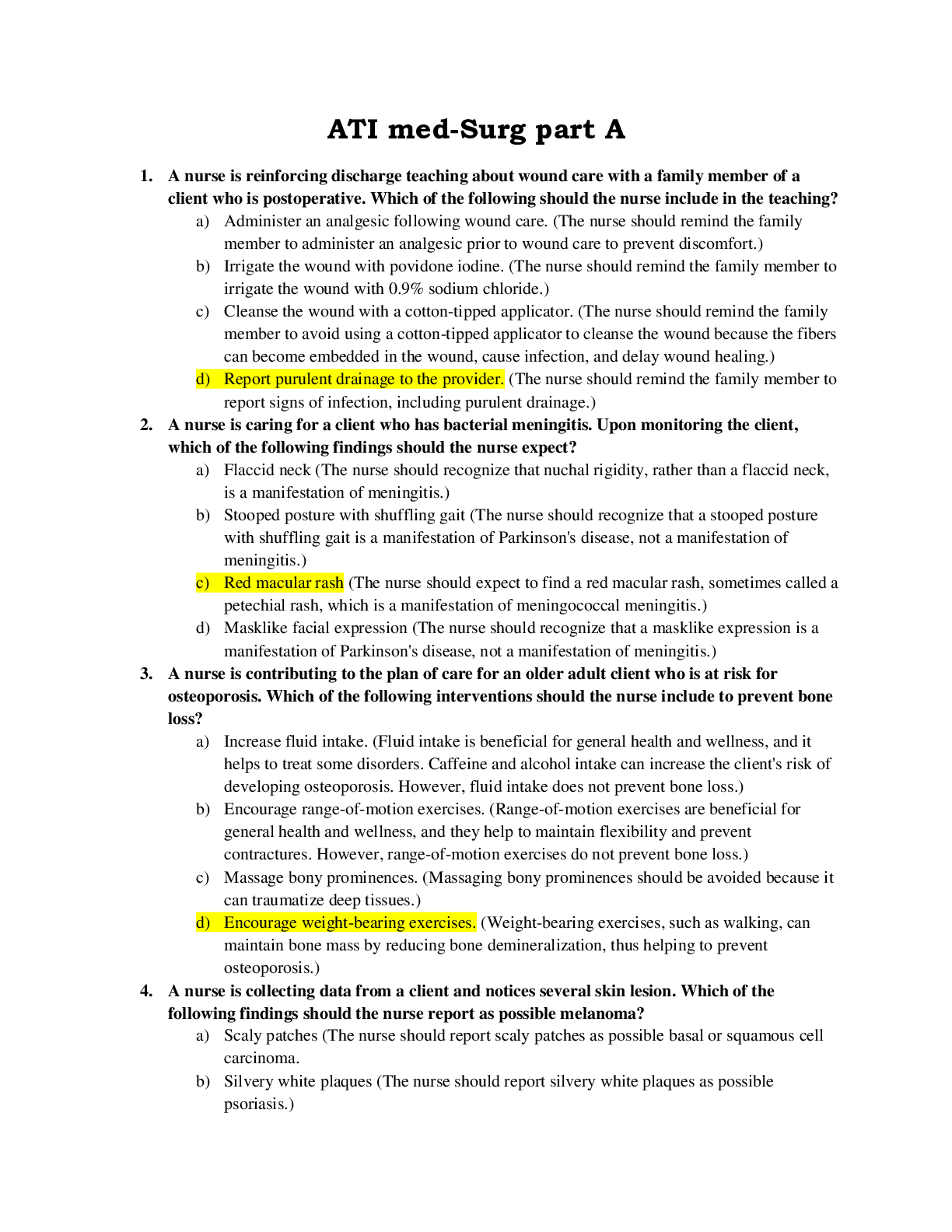

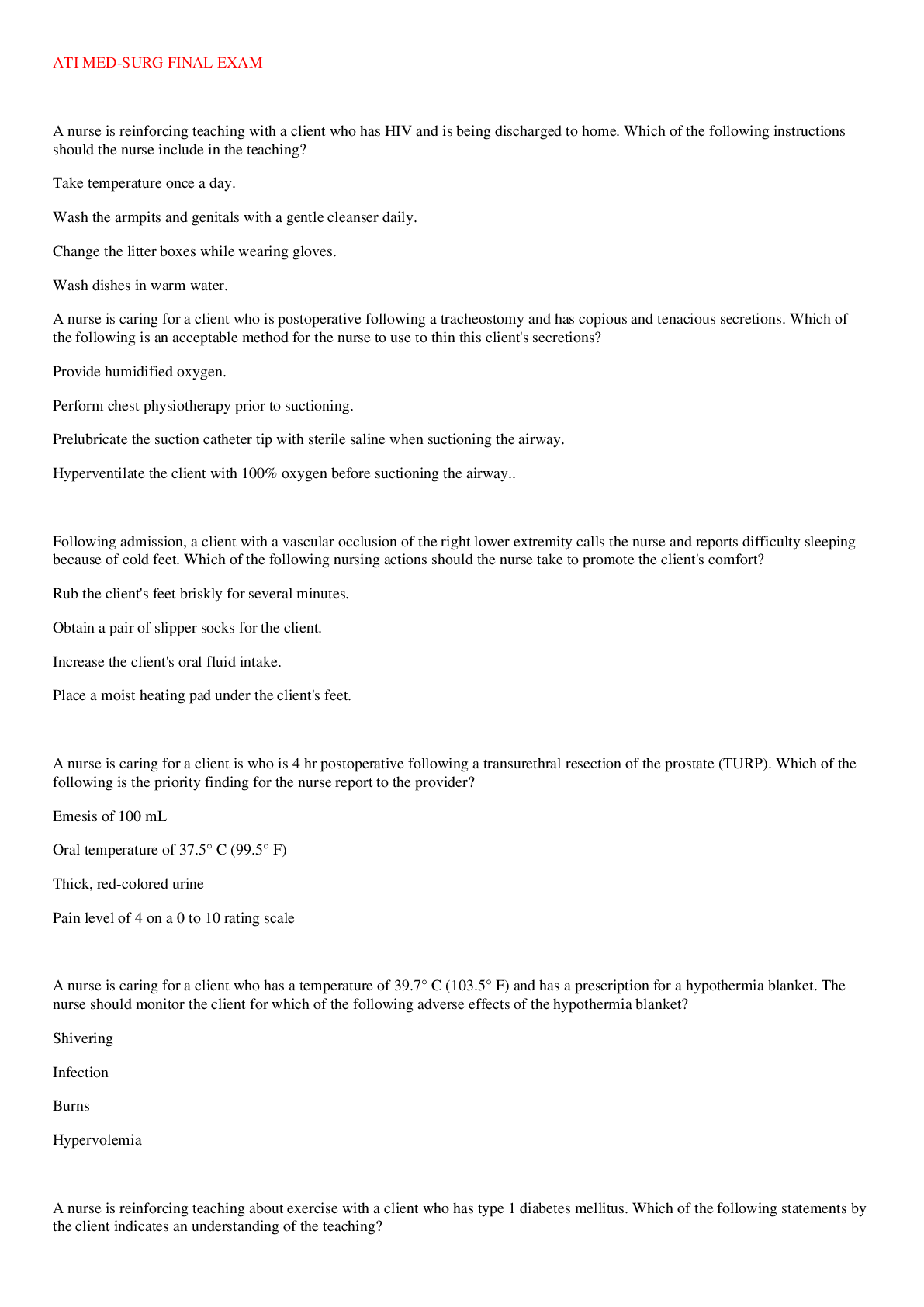

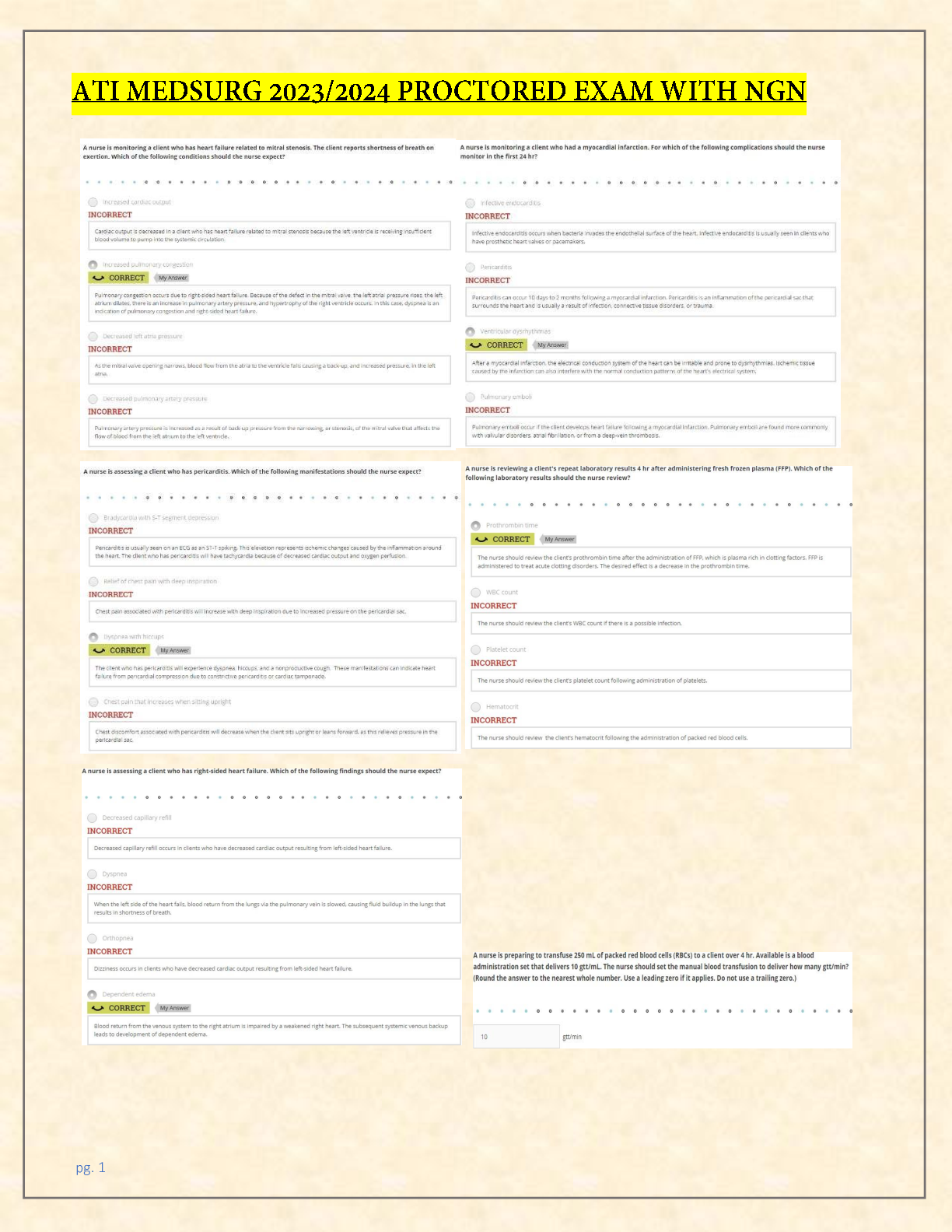
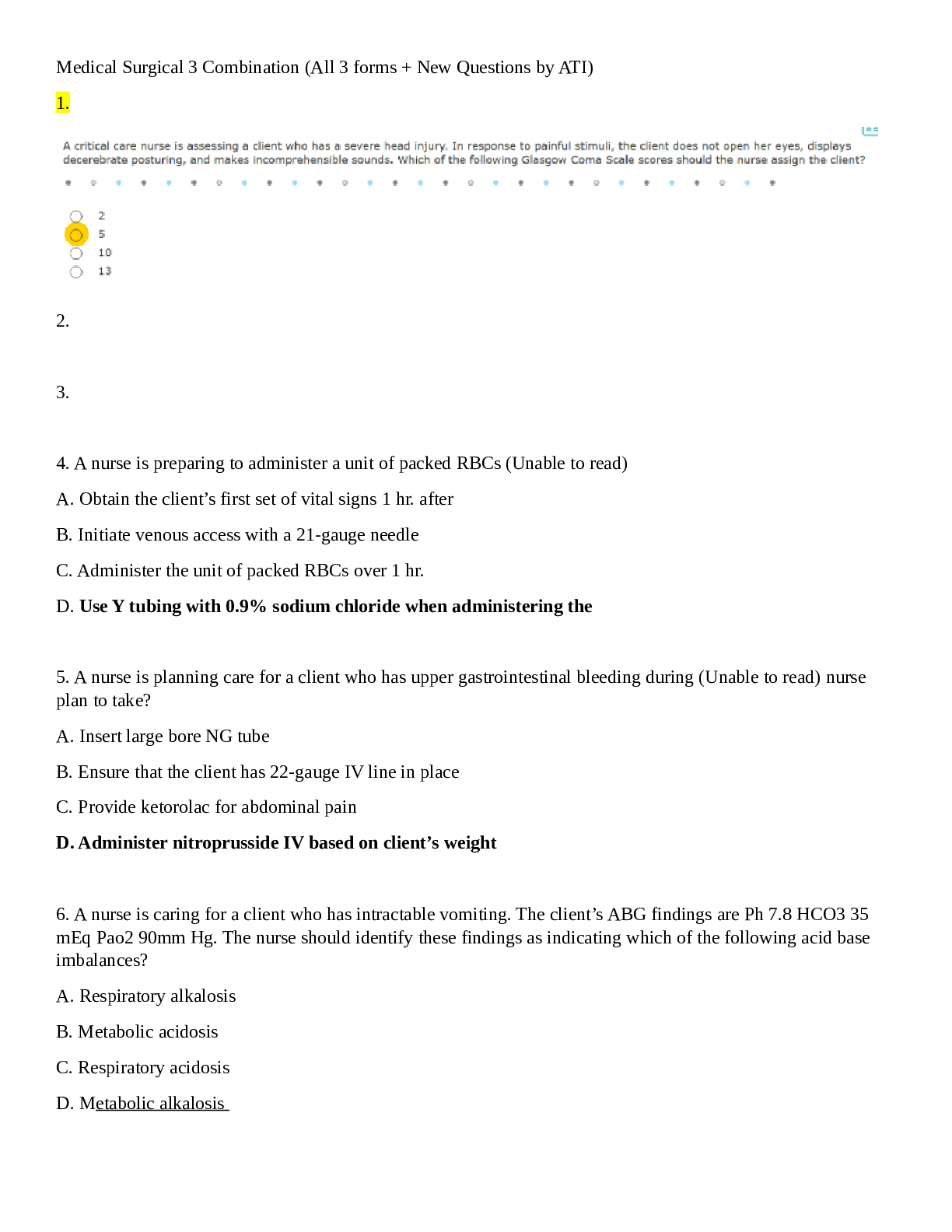
 – Chamberlain College of Nursing.png)

